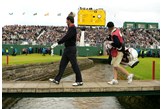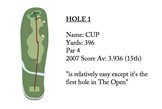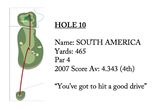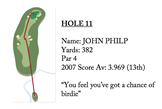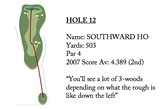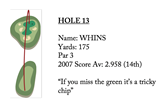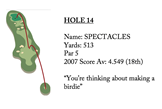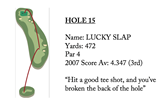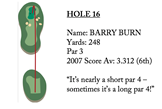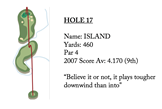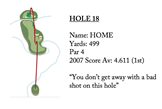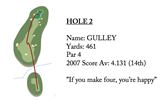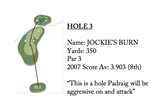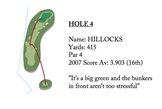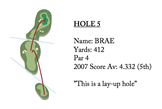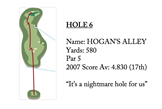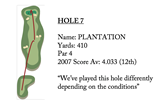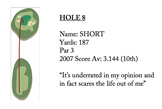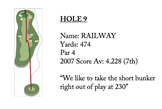Carnoustie Course Guide: By 2007 Champion Harrington and his caddie
Published: Last updated:
Arguably nobody knows Carnoustie better than the last Open winner here and his caddie, who sat down with TG to talk to us through every twist and turn of the Angus venue…
Come the third week in July, Padraig Harrington will be praying for the weather to turn nasty when The Open returns to Carnoustie, scene of the Dubliner’s first of three major triumphs 11 years ago.
After overcoming Sergio Garcia in a play-off in 2007, Harrington not only feels he can win at Carnoustie again, he is convinced he can if the elements are in his favour. He told TG: “If the conditions are beautiful, most players can play their normal game on a links course. But if they’re not beautiful, there are a lot of players who won’t have the wherewithal to get it around a links, whereas it’s second nature to me. It gives me a tremendous advantage, especially when I see my game coming into form.”
Harrington famously defended his Open crown at Royal Birkdale in 2008 (before adding a third major at the PGA the following month), and he told us: “I believe I can win again, I really do. I think I have an advantage with links golf, it comes naturally.”
The same applies to long-time caddie, friend and brother-in-law Ronan Flood, who has been by his side since 2004 and was instrumental in Harrington’s last success at Carnoustie after seeing his employer twice find the Barry Burn on the final hole of regulation play on Sunday.
After some calming words of wisdom from Flood, Harrington regained his composure, got back into the zone and struck a stunning chip to within four feet. He holed the putt for double bogey to get into the play-off with Sergio Garcia, and the rest is history.

Here, Harrington and Flood team up again to provide a hole-by-hole, shot-by-shot analysis on how to play the toughest course on The Open Championship rota.
Carnoustie Course Guide

PH: This hole will be reduced by 15 yards for The Open and is relatively easy except it’s the first hole in The Open! If it wasn’t for that, you’d just lay up short of the bunker on the right, hit a 9-iron into the green, make your par and leave. Straightforward.
RF: We always lay IT up short of the right bunker at about 270 yards – we don’t want to hit it in there. That leaves a 7-9-iron in, and the only trouble is the front right greenside bunker. So if the pin is anywhere on the right – as it was in the 2007 play-off – you’re making sure you carry that and take it out of play to finish pin high.

PH: It’s a big tough hole. Off the tee, you’ve three bunkers to negotiate – one in front of you, one left and one right so you’ve got to thread your ball through those with a driver – Carnoustie forces you into using your driver because generally if you lay up the holes are too long and difficult so you’re putting too much pressure on the second shots. This is why Carnoustie is such a difficult golf course. The bunkers are penal, but you can’t avoid them except by hitting the ball well. You can’t just lay up short of every bunker because it becomes too big a golf course. That done, you’re then hitting into a massively long green.
RF: We will try and carry the second set of bunkers at about the 280-yard mark with a driver, leaving anything from a 4 to 7-iron in depending on the conditions. With the second shot there are bunkers front left and right, but the nasty one is in the middle on the left side – it’s crucial to avoid that. If you make four, you’re happy.

RF: A lot of guys play this in different ways, but we always try to carry the bunker at 250-255 and stay short of the pot bunker at 290. A lot of guys lay it up short of the middle bunkers and leave maybe an 8 or 9-iron, but Padraig prefers to get down there and give himself a birdie chance with a wedge. With that in hand you’re happy to go for any pin, whereas with an 8-9-iron you tend to play it more safely. This is a hole Padraig will be aggressive on and attack.

RF: A slight dog-leg. There’s a short fairway bunker which doesn’t come into play most of the time, apart from when it’s really windy. The one to avoid is on the left, about 250, with another at 290 on the right. We generally hit driver to negotiate the left trap, though there’s a burn down the left so invariably you see a lot of guys playing from the right rough because they’re so afraid of trouble on the left. If you’re coming in off the fairway, it’s a nice approach shot – it’s a big green and the bunkers in front aren’t too stressful. But because the green is so big, getting it pin high can be quite tough at times.

RF: This a lay-up hole. There’s a burn at 280, and two bunkers, and Padraig never hits it over those. We lay it up at the left bunker at 220, generally aiming it at the right-hand bunker with a club that won’t find it. It leaves a slightly longer shot in – anything from 5-iron to a 9-iron. The main trouble is the two bunkers on the left of the huge green. As long as you’re in reasonable shape off the tee, it’s not a bad hole and you’re happy to be going in with a 7-iron to a back pin and a 9-iron to a front pin.

PH: Plays into the wind, with several bunkers down there… it’s a nightmare hole for us. Some players go for it, but many don’t know whether to go for it or not and end up not committing to it. There are so many options and that confuses you. Again, if you lay up at the cross bunkers in front of you, all of a sudden you’re now hitting something like a fairway wood into a bottleneck of a hazard with gorse and out of bounds, and it doesn’t get any easier. You’re kicking the can down the road if you just lay up as you make the next shot harder. Plus, the green is very awkward. This and 18 are the two holes that keep us awake.
RF: The famous Hogan’s Alley, where depending on conditions you’d like to go for it in two. We’ve played it at times where you can y the bunkers at 265 with the second set at 280-300 in play, though the toughest part is the OB down the left. So guys are hitting drivers to give themselves a chance, but they’re always very conscious of that OB and the bunkers on the right. In the final round in the last Open here, Padraig played it as a three shotter. Then you’ve got the burn up there on the right 135 from the front of the green and it goes on for 60 yards or so. It can look easy if you’ve hit a good tee shot, but in reality it’s tricky because of all the trouble. The green is well protected and has some huge slopes: not so bad if you’re there in two, but if you’ve laid back a bit it can be a tricky third shot into the green considering the slopes on it.

RF: Over the years, we’ve played this hole differently depending on the conditions. You have a bunker on the left which is generally not in play, so you’re laying it up short of the two bunkers on the right which are at 270. Generally we play to those even if it’s downwind, leaving around 130 to the front with a short-ish iron depending where the pin is, with the aim to fly the front right bunker. Over the back here is never bad because it’s puttable.

PH: It’s underrated in my opinion and in fact scares the life out of me! It’s 180 yards and a 5 or 6-iron, but the green is elevated and tends to be quite rm so it’s hard to hold the ball. Believe it or not – and is the reason why I think it is underrated – there’s OB five yards left of the green. I fear the 8th a lot.
RF: A great little hole with the green resembling an upturned saucer. There’s OB left and it doesn’t have to be pulled too far to bring that into play. You’re just trying to hit the middle of the green, and if you land it at the front it releases down. That achieved, you’ve got a chance of birdie though walking away with par is nice; there is enough trouble to cause problems, though it looks innocent.

RF: Like all the holes at Carnoustie, the bunkering is great because there’s a mixture of traps which are short and you can take out of play easily, but then there are more just beyond them which definitely come into play, so you’re usually taking on something. With this one we like to take the short right bunker out of play at 230 over it, with a club that won’t reach the left bunker at about 270. The second shot is into quite a big 45-yard green, and again well bunkered – anything over the front right trap slopes down into the green and there’s a deep bunker halfway up it on the left to avoid.

PH: A big par 4, like the 9th. You’ve got to hit a great drive, thread it through the bunkers with the second shot over the burn. The problem is, if you get into trouble and have a go for it you can knock up a six or seven. If you hit a good drive you’re in a good position; again, the more you go through this golf course, the more you realise it only asks you questions if you don’t drive it well. If you drive it well you’re breaking the back of the course, but if you drive it poorly, you’re tempted into a lot of shots that can lead to disaster.
RF: Well bunkered again. There are three at 250 to carry o the tee on the right, one beyond them and one on the left at about 290 – you’re afraid to hit it in there, so you can push it and find the one on the right! For the second shot the burn doesn’t come into play unless you’ve hit it in the bunker or got a bad lie and laid up. Often, the pin is at the back and the key with the approach is to avoid the deep bunkers short left. It’s not terrible but puttable if you’ve run over the back.

RF: Four bunkers, two either side, of the fairway, mean we’ve played this a number of ways over the years. You can carry the traps at about 280, but if you can’t we’ll try and push it down level with the right hand ones. The bunker 220 on the left is the one you’re trying to avoid. If you get it on the fairway here with driver, 5-wood or long iron, you feel you’ve got a chance of birdie with generally a sand wedge, wedge or 9-iron for the shot in. The green is protected left and right by bunkers and there’s a tier in the green, but nothing too stressful.

RF: Two bunkers at about 290-295 are in range with a driver, so you’ll see a lot of 3-woods depending on what the rough is like down the left – if it’s not heavy, some guys won’t mind hitting driver and play their second from there. With the second shot, you’re wary of the four bunkers that are 30 yards short of a shallow green. You’ve also got to remember the 30 yards of dead land in front of the green. We hit a hybrid in the final round last time, but it can be anything from a 5-iron to a 5-wood. Even though the green is shallow, it’s banked up at the back.

RF: A great little par 3. The green is shaped like an eight and the pins are generally in around that pinched in middle. We’ve hit wedges up to 6-irons in there, but any time you’ve got a wedge or a 9-iron in your hands you’re looking for birdie. If you miss the green it’s a tricky chip especially to the narrow portion. If the pin is on the front it’s not so bad and over the back is puttable.

RF: The last par 5 is one you’re thinking about making a birdie on. You’ve got to avoid the bunkers, OB down the left and the gorse down the right. It’s similar to 12 in that you’re usually going for it in two shots. In the final round in 2007 Padraig hit a 5-wood to stay short of the bunker on the right at 270 yards, leaving 225 yards to the front; he delivered last time with a 4-iron. Yes, this route leaves a slightly longer second, but it’s still reachable in two even though it’s a blind shot to the green which doubles up with the 4th. But if you get here trailing by a few shots on Sunday, you’ll definitely take driver and take on the trouble.

PH: A left dog-leg with a fairway that cambers left to right into two bunkers that sit on the outside of the dog-leg, with heavy rough on the corner on the left. So really you’ve got to draw it into the wind to hold it into the fairway. Hit it in either of the bunkers and you’re chipping out, but if you lay up short of the bunkers you’re leaving about 220 to a smallish target… so you’ve got to take them on. Hit a good tee shot, and you’ve broken the back of the hole. It’s a ‘semi-blind’ second – you can just see the top of the flag – and there’s one bunker front right that sneakily gathers balls like nobody’s business and anything hit up the middle or slightly right half of the green seems to go in it. You can make a birdie if you get a good tee shot away, but realistically 14 is your last birdie chance so psychologically it all starts on 15…
RF: A tricky hole. It’s 250 to the first bunker and 290 to the second, but if you pull it left you’ve got rough and gorse to deal with. Over the years we’ve taken it on and if it’s downwind you can get it past the second bunker – coming up short of this can leave you a 4 or 5-iron into the green, which runs away from you. The slopes mean it’s tricky to get close. Generally if you drive it well on to the fairway, it makes a big difference.

PH: A par 3 that can be 250 yards or so and can play into the wind. Years ago it was a driver, but thankfully it’s a maximum 3-wood now and the beauty of this hole is that there is an area short of the green that kicks the ball forward. What we tend to do in tournaments is to hit a long iron even into the wind and try and pitch it short and run it up into the middle front of the green. We’re very comfortable anywhere on this green. This is a hole to make three on… and to definitely avoid the bunkers on the right-hand side. If you do happen to miss it left, you can have a chip and run up the bank which is not disastrous.
RF: It’s nearly a short par 4 – sometimes it’s a long par 4!
You’re just trying to hit it on the green and if you walk o with a par then you’re delighted. It’s protected by five bunkers – two left and three right – and it’s the two closest to the green you’re trying to avoid. You see a lot of players missing the green left and ending up chipping up the hill. We hit a 4-iron into it last time, but we have hit fairway woods into it as well. As I say, you’re always just trying to find the centre of the green. In the play-off Padraig missed it on the left side, but he was fine; it’s a fairly straightforward chip.

PH: Believe it or not, it plays tougher downwind than into. You’ve got a tee shot over the burn, but must stay short of the next burn. And if the fairway gets anywhere near fiery it can be difficult to keep short of it. But you don’t want to lay too far back –if you’re too conservative off the tee you could have 220 yards in, so you’ve got to push it a little further up than you’d like and squeeze it into the bottleneck, taking the water on a little bit on the left-hand side so you can hit a shorter club into the green. The front of the green is all downslope, too, so if you’re hitting a 3 or 4-iron into it downwind could easily go over the back of the green. In the ’07 play-off I hit a good tee shot and a 4-iron in there so it’s a solid second to a big target but, as I say, it’s all about the drive…
RF: Stand on this tee for the first time and you haven’t a clue where to put the ball. You’ve got a burn to carry at about 200 yards and the next burn comes in at around 245-250. In summer, when it’s firm, you’re thinking ‘how can I keep my ball on the fairway?’ In the play-off it was 4-iron, 4-iron… Green-wise you’ve got four bunkers and if you find them, it’s a tough up and down. In ’07 there was gorse to the left of the green, but they’ve taken that away so you can get up and down

PH: The toughest finishing hole in golf. It’s the length of a par 5 and you’ve got out of bounds and water left and water right… What people don’t seem to envisage is that the bunkers on the right are actually in the middle of the fairway from the tee. So you’re aiming dead straight at those and if it’s fiery you can reach them – obviously into the wind it’s a different story. Hitting a good tee shot is crucial. In 2007 Sergio hit 3-iron off the tee, leaving 240 for another 3-iron and he struck a damn good second, even though he found the bunker… You can land on the green and go OB left and long… there’s water short… and you can’t miss right. So much can go wrong. The one shot you don’t want to hit is a mediocre tee shot, because that could mean you’re trying to hit the green from 240 in a crosswind or whatever. With rm, fast fairways, you can reasonably expect to hit driver and 6-iron. It’s a hole that keeps you awake at night.
RF: Everybody knows 18. You spend 17 holes thinking about it. If you’re a couple of shots up, you can play it as a par 5, as Padraig did in the play-off. You don’t get away with a bad shot on this hole. You’re asked to stand up and hit good golf shots, but it’s the final hole of The Open and that’s what you’re meant to do…


